Beneficial
none known
Family: Scarabaeidae Subfamily: Scarabaeinae Genus: Onthophagus Species: Onthophagus foliaceus Lansberge, 1886Lansberge, 1886:
Lansberge J. 1886. Scarabaeides, Buprestides, et Cerembycides de L'Afrique occidentale. Notes from the Leyden Museum. 8: 79-108.
none available
Total body length 8.0–10.0 mm (0.31–0.39 in). Body shape oval; may be caked in dung. Color black; elytraelytra:
the hardened and chitinous wing-cover of a beetle that protect and overlie the flight wing
dark brownish striped with tan. Small-sized Onthophagus, 6-10 mm (rarely, slightly over 10 mm). Clypeusclypeus:
part of the head anterior to the frons; the most anterior portion in dorsal view
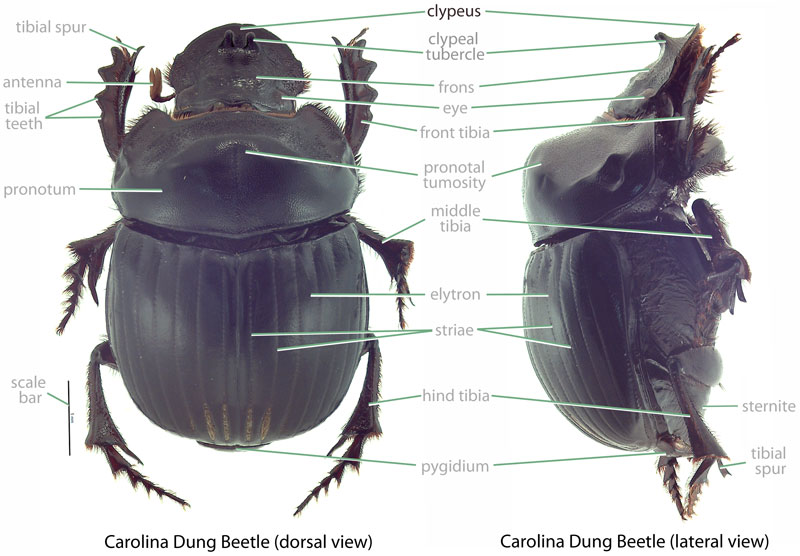 not strongly produced or reflexedreflexed:
not strongly produced or reflexedreflexed:
margin that curves upward
in either sex. Head of major male with single long, curved horn; minor male and female with transversetransverse:
extending horizontally across a surface
ridge near base. Ocular canthuscanthus:
a process extending over and sometimes dividing the eye
not completely dividing eye. Pronotumpronotum:
the dorsal surface of the thorax
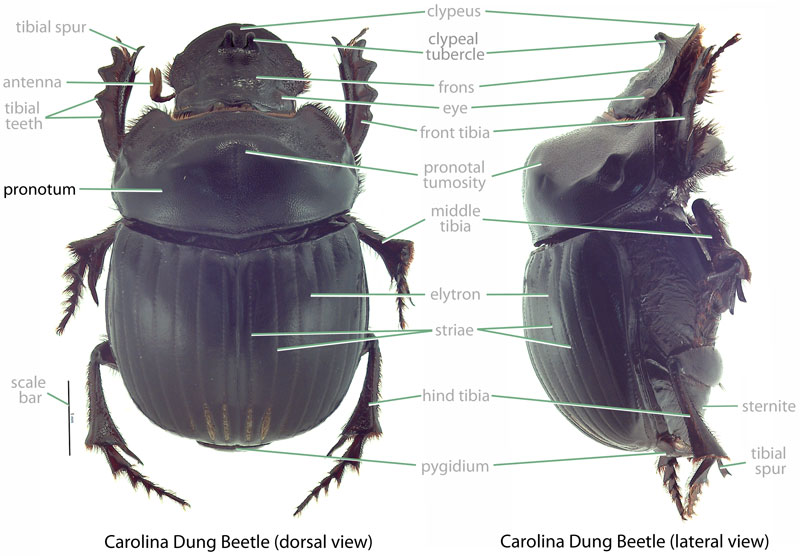 with anterioranterior:
with anterioranterior:
the front or forward; opposite of posterior
angle rounded. Pronotumpronotum:
the dorsal surface of the thorax
 of major male with broad, hump-like process; minor male and female lacking distinct process. Front tibiatibia:
of major male with broad, hump-like process; minor male and female lacking distinct process. Front tibiatibia:
a segment of the leg articulated with the tarsus and femur
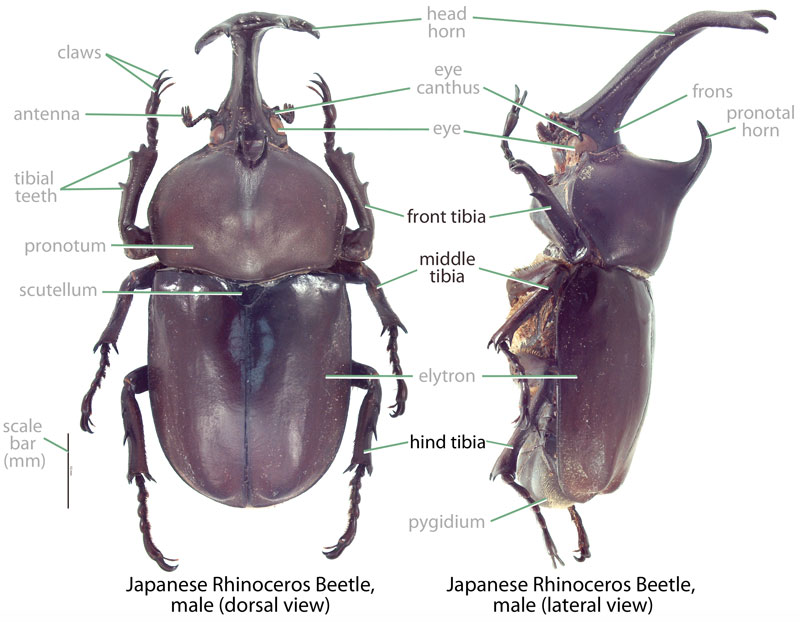 of male slender, female tibiatibia:
of male slender, female tibiatibia:
a segment of the leg articulated with the tarsus and femur
 comparatively more robust. Scutellumscutellum:
comparatively more robust. Scutellumscutellum:
the triangular portion of the thorax between the bases of the elytra
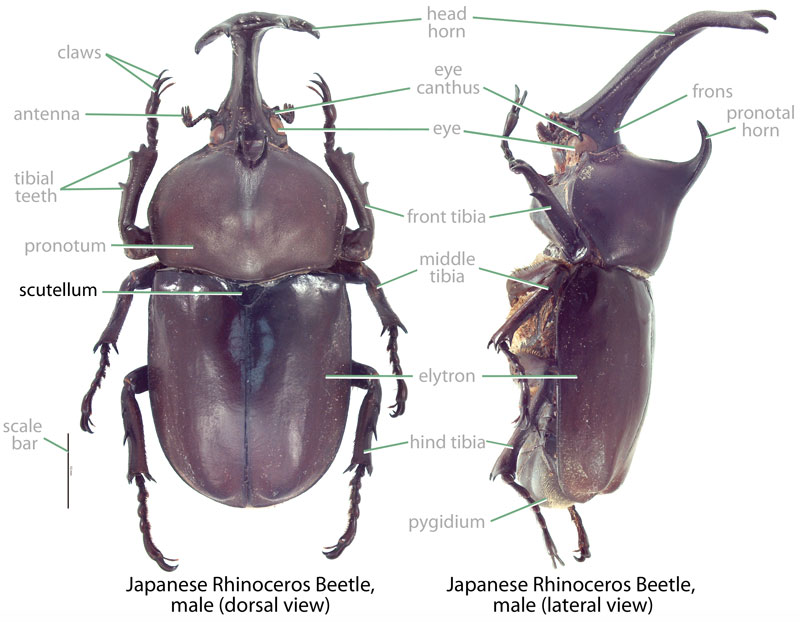 absent.
absent.
Undescribed. For Onthophagus spp. (Ritcher, 1966Ritcher, 1966:
Ritcher P. 1966. White grubs and their allies: a study of North American scarabaeoid larvae. Oregon State University Monographs, Studies in Entomology 4: 1-219.): Grub C-shaped, hump-backed, cylindrical, and cream-colored. Maxillamaxilla:
set of paired mouthparts located posterior to the mandibles
with galeagalea:
outer branch or lobe of the maxilla
 and lacinialacinia:
and lacinialacinia:
inner portion of the maxilla distinctly separate. Epipharynxepipharynx:
distinctly separate. Epipharynxepipharynx:
lobe on the interior surface of the labrum or clypeus
with tormaetormae:
in scarab larvae, sclerotized structures on the ends of the clypeolateral suture extending towards the mesal line
united mesallymesally:
at or near midline of body
, anterioranterior:
the front or forward; opposite of posterior
phoba present. AntennaeAntennae:
paired sensory organ on head, formed from numerous segments
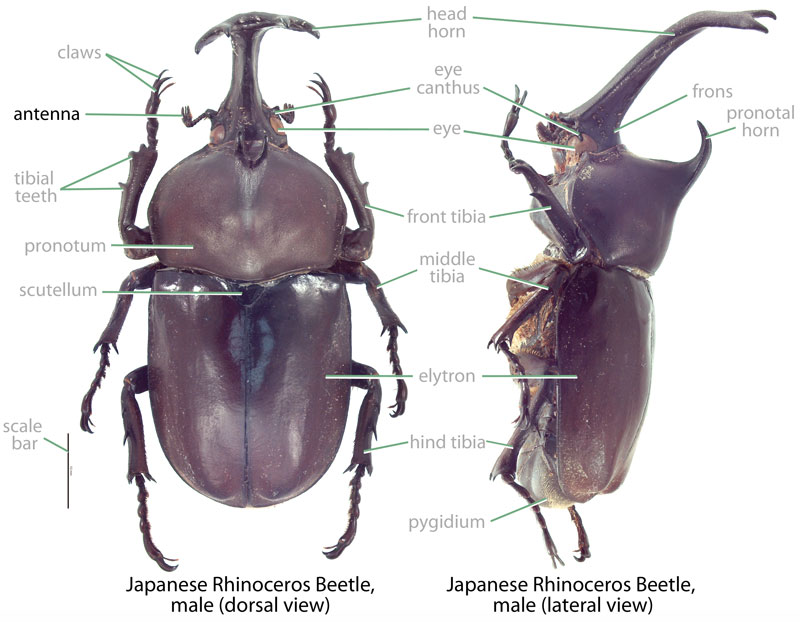 4-segmented, distaldistal:
4-segmented, distaldistal:
situated away from the point of articulation, thus usually furthest from the body
segment much reduced. Legs 2-segmented. Prothoracic shieldprothoracic shield:
the chitinous plate behind the head of larvae
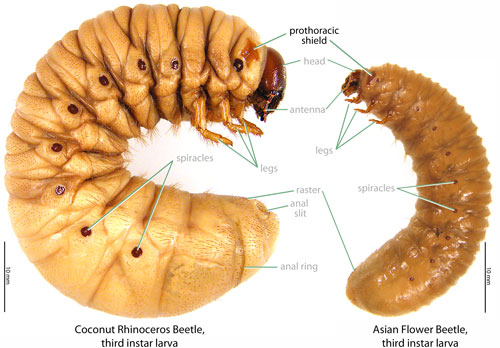 without anteriorly projecting processes. Third abdominal segment bearing a prominent conical, dorsaldorsal:
without anteriorly projecting processes. Third abdominal segment bearing a prominent conical, dorsaldorsal:
of or relating to the upper surface; opposite of ventral
gibbosity covered with numerous short, stout setaesetae:
small, hair-like structure
.
Africa. This species is native to Africa, where it has been recorded from Angola (Lansberge, 1886Lansberge, 1886:
Lansberge J. 1886. Scarabaeides, Buprestides, et Cerembycides de L'Afrique occidentale. Notes from the Leyden Museum. 8: 79-108.).
None. This species feeds on dung as both an adult and larvalarva:
the immature form of an insect; in scarabs, also called grub or white grub; preceded by the egg stage, followed by the pupal stage
 . There are no records of this beetle feeding on live plant tissues.
. There are no records of this beetle feeding on live plant tissues.
Poorly known. Related Onthophagus species are dung tunnelers, with females creating a burrow under or near a dung source (Woodruff, 1973Woodruff, 1973:
Woodruff R. 1973. The scarab beetles of Florida (Coleoptera: Scarabaeidae) part I. The Laparosticti (Subfamilies: Scarabaeinae, Aphodiinae, Hybosorinae, Ochodaeinae, Geotrupinae, Acanthocerinae). Arthropods of Florida and Neighboring Land Areas 8: 1-220.). The burrow is then provisioned with dung in the form of brood balls. Each ball is impregnated with an egg; larval development occurs within the brood ball.
None. This species recycles dung and is beneficial for ranching and farming in Hawaii. Primarily being a dung feeder, this species has never been recorded damaging crop or ornamental plants. Additionally, this scarab is not a threat to native dung beetles because none occur in Hawaii or Guam.
Recorded, not established. In Hawaii, this species was intentionally released in 1975 at Kahua Ranch on Big Island to combat the horn fly (Haematobia irritans), a biting pest of livestock (Nakao and Funasaki, 1979Nakao and Funasaki, 1979:
Nakao H and Funasaki G. 1979. Introductions for biological control in Hawaii: 1975 amp; 1976. Proceedings of the Hawaiian Entomological Society 23: 125-128. full text (accessed 2015)).
Not established or recorded. There are no records of this species from Guam.
In Hawaii, this species was intentionally imported.
This scarab could be confused with the similarly colored, small-sized (6–10 mm) Onthophagus species: Onthophagus granulatus and Onthophagus nuchicornis.
Major males of these species can quickly be distinguished by examining the head armature (O. foliaceus with a single long curving horn versus O. granulatus lacking horns but with a recurvedrecurved:
bending backwards
, produced clypealclypeal:
of, or referring to, the clypeus
apexapex:
point or edge furthest from the body
, O. nuchicornis with a single small, spine-like horn).
Minor males and females are somewhat more difficult to distinguish but can be separated by examining the pronotumpronotum:
the dorsal surface of the thorax
 (O. foliaceus without a distinct process versus O. granulatus with 4 tubercle-like processes, O. nuchicornis with a rounded peg-like process).
(O. foliaceus without a distinct process versus O. granulatus with 4 tubercle-like processes, O. nuchicornis with a rounded peg-like process).
Onthophaghus alterneater D'Orbigny
Report your observation of this beneficial species at our iNaturalist project.